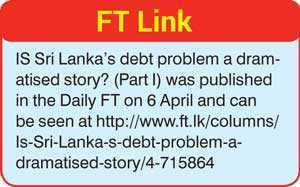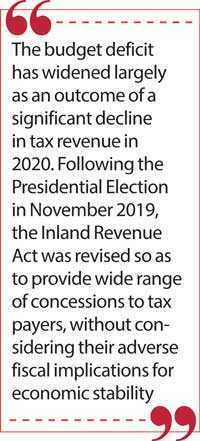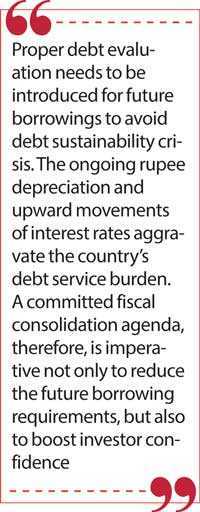Saturday Apr 19, 2025
Saturday Apr 19, 2025
Tuesday, 20 April 2021 00:10 - - {{hitsCtrl.values.hits}}

The CBSL has introduced several interim measures in recent weeks to ease the external payments situation and the debt burden, and some of those measures were withdrawn in double quick time. Making the second change in one month, the CBSL, last Friday, doubled the time period for foreign exchange earnings conversion given for exporters from two weeks to 30 days. Such measures coupled with the bilateral swap arrangements and other foreign borrowings may be imperative to meet the immediate debt commitments. However, such efforts would be futile in the medium and long run without addressing the root-cause of the debt problem, i.e. fiscal imbalance
 Government borrowing is rising rapidly amidst the widening budget deficit, which rose to 12% of GDP in 2020. This year’s deficit is likely to be even higher in the backdrop of the pandemic-hit economic activities, rupee depreciation and interest rate hike.
Government borrowing is rising rapidly amidst the widening budget deficit, which rose to 12% of GDP in 2020. This year’s deficit is likely to be even higher in the backdrop of the pandemic-hit economic activities, rupee depreciation and interest rate hike.
Given the revenue shortfalls that arose from the haphazard tax cuts implemented in 2019, the total tax revenue is hardly sufficient to meet debt service payments. Interest payments alone account for 50% of tax revenue. Foreign debt commitments in the next 12 months amount to 50% of the country’s export earnings.
Inevitably, the Government has to raise new loans continuously to repay the old loans. This type of debt rollover situation is known as the “debt trap” in which the borrowing country finds it difficult to meet the debt commitments, typically because high interest payments prevent repayment of the principal
Hence, it is inaccurate to identify Sri Lanka’s debt problem as the most dramatised story as stated by the Secretary to the President Dr. P.B. Jayasundera at a recent webinar. The debt burden has become a bitter reality in spite of the country’s unblemished track record of debt settlements, as I explained in the previous Daily FT column on this topic (Please see http://www.ft.lk/columns/Is-Sri-Lanka-s-debt-problem-a-dramatised-story/4-715864).
Debt rollover
In response to an alleged erroneous report appeared recently in Sunday Times on a planned delay in debt service commitments, the Central Bank of Sri Lanka (CBSL) states that the Government has no intention to tarnish its unblemished debt service record by delaying the settlement of maturing debt obligations.
However, the concerned newspaper claims that it received information from the CBSL that market participants holding such debt instruments have expressed their willingness to rollover a sizeable portion of these liabilities fallen due in the period ahead. One could interpret such debt “rollover” as postponement of debt settlements.
At its most recent Monetary Policy Review (MPR) meeting, the CBSL viewed debt settlement as a smooth operation, and thus, downplayed the gravity of the debt burden amidst fiscal deterioration and balance of payments difficulties.
The MPR states, “… the CBSL and the Government continue to engage with investment and lending partners to secure foreign financing and remain committed to honouring foreign currency debt service obligations on time.”
 Tax revenue falling
Tax revenue falling
The budget deficit has widened largely as an outcome of a significant decline in tax revenue in 2020. Following the Presidential Election in November 2019, the Inland Revenue Act was revised so as to provide wide range of concessions to tax payers, without considering their adverse fiscal implications for economic stability.
Accordingly, personal income tax rates, tax-free thresholds and tax slabs were relaxed significantly with effect from 1 January 2020.
Also, Pay-As-You-Earn (PAYE) tax on employment receipts, withholding Tax and Economic Service Charge were removed effective from the above date. Downward revisions were made to the Value Added Tax and Nation Building Tax to stimulate business activities.
As a result, the total tax revenue was down by 30% from Rs. 1,613 billion in January-November 2019 to Rs. 1,128 billion in the same period of 2020. Thus, the tax revenue realised in 2020 is likely to be less than the projected tax revenue of Rs. 1,358 billion in the Budget speech 2021.
The tax revenue expected in the Budget speech for this year is Rs. 1,724 billion, and it appears to be over-optimistic, given the lower tax rates and slowdown in economic activities due to the pandemic.
 Budget deficit expanding
Budget deficit expanding
As a result of the decline in tax revenue, the budget deficit which stood at Rs. 913.6 billion in January to November in 2019 rose to Rs. 1,576 billion in the same period of 2020.
In consequence, the budget deficit to GDP ratio increased from 9.6% in 2019 to around 12% in 2020. This contrasts with the anticipated deficit of 7.9% of GDP for 2020 given in the Budget speech-2020.
Rupee depreciation and interest rate hikes
The rupee continues to depreciate further as the selling rate of dollar recorded over Rs. 205 per dollar and the buying rate over Rs. 200 per dollar last week. Meanwhile, the yield rates of Treasury bills have moved upwards in recent auctions reflecting the demand pressures exerted by heavy Government borrowings on the money market.
The country has also been experiencing capital outflows from the Government security market and the stock market in recent months, worsening the fiscal and balance of payments positions.
As revealed at the previous MPR meetings, the declared policy of the CBSL was to keep the exchange rate around Rs. 185 per dollar while maintaining low interest rates.
Contradicting such policy stance, I reiterated in the earlier articles of this column that rupee depreciation and interest rate hike are unavoidable in terms of the phenomenon of “impossible trinity” or “policy trilemma”, which asserts that no central bank can fix the exchange rate and interest rates at the same time without experiencing capital outflows.
Weaker rupee escalates debt service cost
Weakening of the rupee results in an increase in the rupee cost of foreign debt repayments and interest payments. It leads to further enhance the Government expenditure and budget deficit, requiring to raise fresh loans.
For instance, the Government now has to pay additional Rs. 20 for each dollar of foreign debt settlement at the current selling rate of Rs. 205 per dollar as against Rs. 185 per dollar that prevailed six months ago.
This means an additional cost of Rs. 134 billion will have to borne in repaying the principal and interest payments of foreign debt amounting to $ 6,691 million fallen due in the next 12 months. The additional rupee cost goes up further as the rupee depreciates in time to come.
 Sri Lanka to receive SDR allocation from IMF
Sri Lanka to receive SDR allocation from IMF
The International Monetary Fund (IMF) has decided to support its member countries’ foreign exchange reserves through a new allocation of Special Drawing Rights (SDR) of $ 650 billion. SDRs is the reserve asset of the IMF, which could be exchangeable for dollars, euros, sterling, yen and Chinese yuan.
The new allocation to be implemented in August will benefit around 75 low income countries including Sri Lanka to help them dealing with the external financial implications of the COVID-19 pandemic. It will also benefit all countries to ease external sector constraints and to boost their economies, and thereby to attain global economic recovery.
The IMF allocates SDRs to members in proportion to their quota shares. The new SDR allocation will provide a direct liquidity boost for all IMF member countries without adding to debt burdens. Members receiving SDRs can transfer them to other members in exchange for convertible or hard currencies to meet their external payments needs.
Sri Lanka will receive $ 800 million under the new SDR allocation, and this will help to improve the country’s debt servicing capacity in the short run.
However, the authorities have expressed their unwillingness to have any financial arrangement with the IMF, as the conditionalities attached to such programmes are said to be incompatible with the Government’s home-grown economic development strategy.
Foreign borrowing by finance companies allowed
The CBSL introduced new regulations a few days ago to permit Licensed Finance Companies (LFCs) to obtain low-cost borrowing from foreign sources to support their business expansions. The LFCs satisfying criteria such as utilisation for purposes with national interest, maturities over five years, complying with the prudential requirements, etc. are eligible to raise foreign currency borrowings on a case-by-case basis up to 10% of total assets. The tenure of foreign currency borrowings shall be two years or more.
Any foreign currency borrowings up to 10% of a company’s total assets do not require CBSL approval except prior notification, while the borrowings exceeding 10% require prior approval of CBSL.
LFCs are allowed to borrow foreign currency up to 20% of a company’s total assets under three stages based on the overall performance of each company including capital and liquidity levels, utilisation purposes, nature of collaterals and the credit rating.
While these new regulations are helpful to raise foreign borrowings amidst the country’s dwindling reserve position, they will lead to aggravate the debt burden since principal repayments and interest payments on account of such loans will have to be met through the country’s foreign reserves, irrespective of the type of the borrower.
Already, the total foreign debt stock held by the Government, Central Bank, commercial banks and blue-chip companies amounts to $ 55 billion, equivalent to 65% of GDP.
 Policy reforms for debt sustainability
Policy reforms for debt sustainability
The CBSL has introduced several interim measures in recent weeks to ease the external payments situation and the debt burden, and some of those measures were withdrawn in double quick time. Making the second change in one month, the CBSL, last Friday, doubled the time period for foreign exchange earnings conversion given for exporters from two weeks to 30 days.
Such measures coupled with the bilateral swap arrangements and other foreign borrowings may be imperative to meet the immediate debt commitments.
However, such efforts would be futile in the medium and long run without addressing the root-cause of the debt problem, i.e. fiscal imbalance. The haphazard tax cuts implemented in 2019 without considering their adverse economic effects have led to expand the budget deficit compelling the Government to borrow more and more. Hence, fiscal consolidation is essential, possibly by reviving the Fiscal Responsibility (Management) Act.
Past foreign borrowings were raised from capital markets, particularly from China, without paying adequate attention to the rate of return on investment, unlike in the case of loans disbursed by the multilateral agencies such as the World Bank and the Asian Development Bank.
As a result, many debt-funded projects have failed to generate economic growth or foreign exchange earnings. This makes debt service payments extremely difficult in the next five years when the bulk of such loans get matured. Proper debt evaluation needs to be introduced for future borrowings to avoid debt sustainability crisis.
The ongoing rupee depreciation and upward movements of interest rates aggravate the country’s debt service burden.
A committed fiscal consolidation agenda, therefore, is imperative not only to reduce the future borrowing requirements, but also to boost investor confidence.
(Prof. Sirimevan Colombage is Emeritus Professor in Economics at the Open University of Sri Lanka and Senior Visiting Fellow of Advocata Institute. He is former Director of Statistics, Central Bank of Sri Lanka and reachable through [email protected])

Discover Kapruka, the leading online shopping platform in Sri Lanka, where you can conveniently send Gifts and Flowers to your loved ones for any event including Valentine ’s Day. Explore a wide range of popular Shopping Categories on Kapruka, including Toys, Groceries, Electronics, Birthday Cakes, Fruits, Chocolates, Flower Bouquets, Clothing, Watches, Lingerie, Gift Sets and Jewellery. Also if you’re interested in selling with Kapruka, Partner Central by Kapruka is the best solution to start with. Moreover, through Kapruka Global Shop, you can also enjoy the convenience of purchasing products from renowned platforms like Amazon and eBay and have them delivered to Sri Lanka.
Discover Kapruka, the leading online shopping platform in Sri Lanka, where you can conveniently send Gifts and Flowers to your loved ones for any event including Valentine ’s Day. Explore a wide range of popular Shopping Categories on Kapruka, including Toys, Groceries, Electronics, Birthday Cakes, Fruits, Chocolates, Flower Bouquets, Clothing, Watches, Lingerie, Gift Sets and Jewellery. Also if you’re interested in selling with Kapruka, Partner Central by Kapruka is the best solution to start with. Moreover, through Kapruka Global Shop, you can also enjoy the convenience of purchasing products from renowned platforms like Amazon and eBay and have them delivered to Sri Lanka.